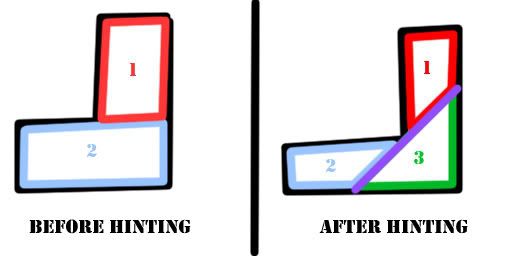I've been reading alot about hint brushes, and what I gather is this: so tell me if iim right, close or wrong. Yes, I read the tutorial.
When you build brushes in HL, the engine splits up world brushes where they contact, so if you build one big flat brush for the floor, stick a box on top of it for a crate (and keep it a world brush) the box will break up the floor into pieces where the lines intersect, and will show up using gl_wireframe 2.
In areas with lots of turns, you want to break up the geometry so the engine will only render what the player can actually see, so if you do a corner of a hallway, you only want the engine to render the walls/floor/ceiling that the player can actually see, not the entire length of the brushes (i am assuming the hallway runs far out of the player's sight)
So, basically, does all a hint brush do is break up the brush geometry where it touches other brushes, thereby creating more brushes, but resulting in the engine rendering less and smaller brushes? If that is the case, why not just use the clip tool to clip the brushes were the hint brush would touch? or why not just make a brush a func_illusionary instead of hint?
yes, I'm a mapping noob, but I'm a smart mapping noob and I like to learn.
hint brushes: basic understanding?
Created 17 years ago2007-01-09 19:26:48 UTC by
 eightballrota
eightballrota
Created 17 years ago2007-01-09 19:26:48 UTC by
![]() eightballrota
eightballrota
Posted 17 years ago2007-01-09 19:26:48 UTC
Post #209149
Posted 17 years ago2007-01-09 20:22:51 UTC
Post #209160
You're on the right track with the way they optimize, but rather than splitting world geometry, it splits vis leaves. Vis leaves need to be efficient in what they cover, or else, as in the example you gave, the entire length of a coridor will be rendered, regardless of what is in view.In the above picture, you can see (with my crazy Photoshop skillz) what happens when a hint brush is applied to something like this corner. Before hinting, visleaf 1 can see straight into leaf 2, and vice versa, so both leaves are rendered all the time. However, after a hint brush is added in (the purple line), area one can only see area 3, and area 2 can only see area 3. So if the player was to stand in visleaf 1, leaf 2 would not be rendered. Of course, this isn't the only case where hinting can become useful. Experiment with gl_wireframe a little and see where your map needs these useful little things.
Here's a little guide on optimization. The guide itself is for Source, but the hinting principles remain the same. So >>>here<<< you go.
That's hinting, in a nut shell
Here's a little guide on optimization. The guide itself is for Source, but the hinting principles remain the same. So >>>here<<< you go.
That's hinting, in a nut shell

Posted 17 years ago2007-01-10 00:11:17 UTC
Post #209168
that site has alot of good stuff on it thanks for the links...
Just thought of another question? any ideas on how to do hint brushes in corridors with curved ceilings? I have tunnells with curved ceilings, made with the arch tool, I suppose I could just match up individual hint brushes to the ceiling brushes and make sure they all touch...
Just thought of another question? any ideas on how to do hint brushes in corridors with curved ceilings? I have tunnells with curved ceilings, made with the arch tool, I suppose I could just match up individual hint brushes to the ceiling brushes and make sure they all touch...
Posted 17 years ago2007-01-10 01:05:13 UTC
Post #209171
It's okay if a hint brush intersects an other brush. If you want to have a hint brush go from the floor to the ceiling, then simply make it go striaght from the floor to the highest part of the arch so the entire area is covered, and clip it into shape. I would strongly advise you not make individual brushes for hinting, as there is a much greater possibility for error, and it can be a real pain in the ass to work with or around.
I'm not sure if hint brushes partially (or completely ) in the void would cause issues. If not, then it makes no difference whether or not you clipped it into the shape of the arch (I figured I'd say that because clipping with arches can be a pain in the nuts). Experiment
) in the void would cause issues. If not, then it makes no difference whether or not you clipped it into the shape of the arch (I figured I'd say that because clipping with arches can be a pain in the nuts). Experiment 
I'm not sure if hint brushes partially (or completely
 ) in the void would cause issues. If not, then it makes no difference whether or not you clipped it into the shape of the arch (I figured I'd say that because clipping with arches can be a pain in the nuts). Experiment
) in the void would cause issues. If not, then it makes no difference whether or not you clipped it into the shape of the arch (I figured I'd say that because clipping with arches can be a pain in the nuts). Experiment 
Posted 17 years ago2007-01-12 11:09:47 UTC
Post #209419
thanks for the help. I didnt bother to clip the hunt brush to match the arch, and it still worked fine in the map, just like it should. Dropped my w_poly's by 200.
You must be logged in to post a response.

